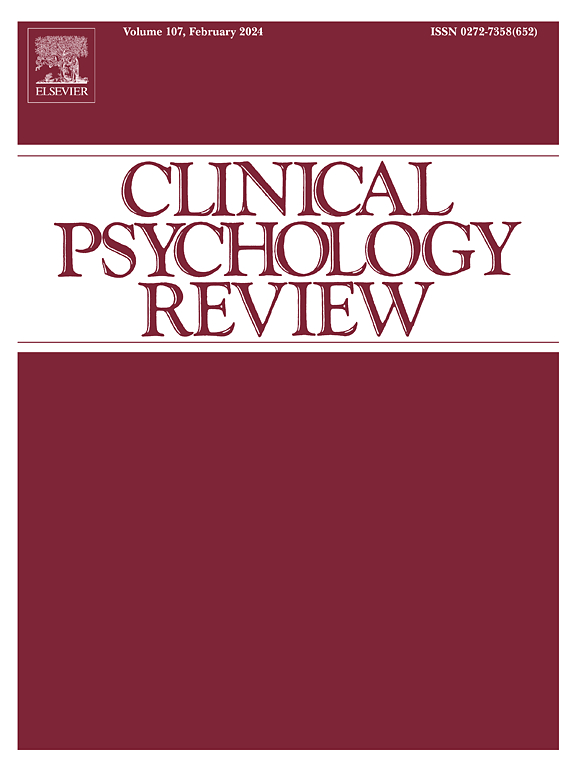The use of biomarkers as measures of PTSD treatment efficacy and predictors of treatment outcomes: A systematic review
IF 12.2
1区 心理学
Q1 PSYCHOLOGY, CLINICAL
引用次数: 0
Abstract
The efficacy of posttraumatic stress disorder (PTSD) treatments might be hampered by individual differences. In order to maximize treatment efficacy in existing and newly developed interventions, controlling for individual variables is essential in treatment research. Given the marked physiological correlates of PTSD, biomarkers represent a promising solution. Throughout the PTSD literature, biomarkers have been used to assess treatment effects and predict treatment outcomes. However, the wide variety of biomarkers studied, along with several conflicting results, hinder researchers' abilities to comprehensively interpret the results reported. This systematic review of the literature aimed to identify and classify all biomarkers used to assess the efficacy of PTSD interventions and identify pre-treatment biomarkers able to predict treatment outcomes. Following PRISMA guidelines, we identified 70 studies that assessed biomarkers sensitivity to treatment effects and 25 that used biomarkers to predict treatment outcomes. Well-established treatments and newly developed protocols were included. The results were classified and interpreted by biomarker type. Indicators of neuroanatomical structures and functions were the most commonly studied biomarkers, followed by markers of cardiac activation and glucocorticoid analytes. Cardiac activation markers, and concretely heart rate reactivity to trauma cues, showed the most consistent findings, serving as a valuable method to assess treatment effects across different populations and treatment modalities. Other biomarkers showed promising trends both as predictors of treatment outcomes and measures of treatment efficacy, although essential methodological differences significantly impacted the comparison across studies.
生物标志物作为创伤后应激障碍治疗疗效和治疗结果预测指标的使用:一项系统综述
创伤后应激障碍(PTSD)的治疗效果可能会受到个体差异的影响。为了最大限度地提高现有和新开发干预措施的疗效,在治疗研究中控制个体变量至关重要。鉴于创伤后应激障碍具有明显的生理相关性,生物标志物是一种很有前景的解决方案。在整个创伤后应激障碍文献中,生物标志物一直被用于评估治疗效果和预测治疗结果。然而,由于所研究的生物标志物种类繁多,且存在一些相互矛盾的结果,这阻碍了研究人员全面解读所报告结果的能力。本系统性文献综述旨在对所有用于评估创伤后应激障碍干预疗效的生物标志物进行识别和分类,并识别能够预测治疗结果的治疗前生物标志物。根据 PRISMA 指南,我们确定了 70 项评估生物标志物对治疗效果敏感性的研究和 25 项使用生物标志物预测治疗结果的研究。其中包括成熟的治疗方法和新开发的方案。研究结果按生物标志物类型进行了分类和解释。神经解剖结构和功能指标是最常研究的生物标记物,其次是心脏活化标记物和糖皮质激素分析物。心脏活化标志物,具体地说是心率对创伤线索的反应性,显示了最一致的研究结果,是评估不同人群和治疗方式的治疗效果的重要方法。其他生物标志物在预测治疗结果和衡量治疗效果方面都显示出良好的趋势,尽管方法上的本质区别严重影响了不同研究之间的比较。
本文章由计算机程序翻译,如有差异,请以英文原文为准。
求助全文
约1分钟内获得全文
求助全文
来源期刊

Clinical Psychology Review
PSYCHOLOGY, CLINICAL-
CiteScore
23.10
自引率
1.60%
发文量
65
期刊介绍:
Clinical Psychology Review serves as a platform for substantial reviews addressing pertinent topics in clinical psychology. Encompassing a spectrum of issues, from psychopathology to behavior therapy, cognition to cognitive therapies, behavioral medicine to community mental health, assessment, and child development, the journal seeks cutting-edge papers that significantly contribute to advancing the science and/or practice of clinical psychology.
While maintaining a primary focus on topics directly related to clinical psychology, the journal occasionally features reviews on psychophysiology, learning therapy, experimental psychopathology, and social psychology, provided they demonstrate a clear connection to research or practice in clinical psychology. Integrative literature reviews and summaries of innovative ongoing clinical research programs find a place within its pages. However, reports on individual research studies and theoretical treatises or clinical guides lacking an empirical base are deemed inappropriate for publication.
 求助内容:
求助内容: 应助结果提醒方式:
应助结果提醒方式:


